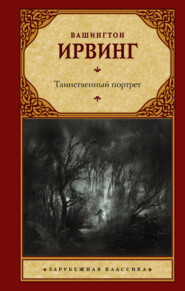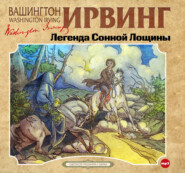По всем вопросам обращайтесь на: info@litportal.ru
(©) 2003-2025.
✖
Abbotsford and Newstead Abbey
Настройки чтения
Размер шрифта
Высота строк
Поля
"The mansion's self was vast and venerable,
With more of the monastic than has been
Elsewhere preserved; the cloisters still were stable,
The cells, too, and refectory, I ween;
An exquisite small chapel had been able,
Still unimpair'd, to decorate the scene;
The rest had been reformed, replaced, or sunk,
And spoke more of the friar than the monk.
"Huge halls, long galleries, spacious chambers, joined
By no quite lawful marriage of the arts,
Might shock a connoisseur; but when combined
Formed a whole, which, irregular in parts,
Yet left a grand impression on the mind,
At least of those whose eyes were in their hearts."
It is not my intention to lay open the scenes of domestic life at the Abbey, nor to describe the festivities of which I was a partaker during my sojourn within its hospitable walls. I wish merely to present a picture of the edifice itself, and of those personages and circumstances about it, connected with the memory of Byron.
I forbear, therefore, to dwell on my reception by my excellent and amiable host and hostess, or to make my reader acquainted with the elegant inmates of the mansion that I met in the saloon; and I shall pass on at once with him to the chamber allotted me, and to which I was most respectfully conducted by the chamberlain.
It was one of a magnificent suite of rooms, extending between the court of the cloisters and the Abbey garden, the windows looking into the latter. The whole suite formed the ancient state apartment, and had fallen into decay during the neglected days of the Abbey, so as to be in a ruinous condition in the time of Lord Byron. It had since been restored to its ancient splendor, of which my chamber may be cited as a specimen. It was lofty and well proportioned; the lower part of the walls was panelled with ancient oak, the upper part hung with gobelin tapestry, representing oriental hunting scenes, wherein the figures were of the size of life, and of great vivacity of attitude and color.
The furniture was antique, dignified, and cumbrous. High-backed chairs curiously carved, and wrought in needlework; a massive clothes-press of dark oak, well polished, and inlaid with landscapes of various tinted woods; a bed of state, ample and lofty, so as only to be ascended by a movable flight of steps, the huge posts supporting a high tester with a tuft of crimson plumes at each corner, and rich curtains of crimson damask hanging in broad and heavy folds.
A venerable mirror of plate glass stood on the toilet, in which belles of former centuries may have contemplated and decorated their charms. The floor of the chamber was of tesselated oak, shining with wax, and partly covered by a Turkey carpet. In the centre stood a massy oaken table, waxed and polished as smooth as glass, and furnished with a writing-desk of perfumed rosewood.
A sober light was admitted into the room through Gothic stone-shafted casements, partly shaded by crimson curtains, and partly overshadowed by the trees of the garden. This solemnly tempered light added to the effect of the stately and antiquated interior.
Two portraits, suspended over the doors, were in keeping with the scene. They were in ancient Vandyke dresses; one was a cavalier, who may have occupied this apartment in days of yore, the other was a lady with a black velvet mask in her hand, who may once have arrayed herself for conquest at the very mirror I have described.
The most curious relic of old times, however, in this quaint but richly dight apartment, was a great chimney-piece of panel-work, carved in high relief, with niches or compartments, each containing a human bust, that protruded almost entirely from the wall. Some of the figures were in ancient Gothic garb; the most striking among them was a female, who was earnestly regarded by a fierce Saracen from an adjoining niche.
This panel-work is among the mysteries of the Abbey, and causes as much wide speculation as the Egyptian hieroglyphics. Some suppose it to illustrate an adventure in the Holy Land, and that the lady in effigy had been rescued by some Crusader of the family from the turbaned Turk who watches her so earnestly. What tends to give weight to these suppositions is, that similar pieces of panel-work exist in other parts of the Abbey, in all of which are to be seen the Christian lady and her Saracen guardian or lover. At the bottom of these sculptures are emblazoned the armorial bearings of the Byrons.
I shall not detain the reader, however, with any further description of my apartment, or of the mysteries connected with it. As he is to pass some days with me at the Abbey, we shall have time to examine the old edifice at our leisure, and to make ourselves acquainted, not merely with its interior, but likewise with its environs.
THE ABBEY GARDEN
The morning after my arrival, I rose at an early hour. The daylight was peering brightly between the window curtains, and drawing them apart, I gazed through the Gothic casement upon a scene that accorded in character with the interior of the ancient mansion. It was the old Abbey garden, but altered to suit the tastes of different times and occupants. In one direction were shady walls and alleys, broad terraces and lofty groves; in another, beneath a gray monastic-looking angle of the edifice, overrun with ivy and surmounted by a cross, lay a small French garden, with formal flower-pots, gravel walks, and stately stone balustrades.
The beauty of the morning, and the quiet of the hour, tempted me to an early stroll; for it is pleasant to enjoy such old-time places alone, when one may indulge poetical reveries, and spin cobweb fancies, without interruption. Dressing myself, therefore, with all speed, I descended a small flight of steps from the state apartment into the long corridor over the cloisters, along which I passed to a door at the farther end. Here I emerged into the open air, and, descending another flight of stone steps, found myself in the centre of what had once been the Abbey chapel.
Nothing of the sacred edifice remained, however, but the Gothic front, with its deep portal and grand lancet window, already described. The nave, the side walls, the choir, the sacristy, all had disappeared. The open sky was over my head, a smooth shaven grass-plot beneath my feet. Gravel walks and shrubberies had succeeded to the shadowy isles, and stately trees to the clustering columns.
"Where now the grass exhales a murky dew,
The humid pall of life-extinguished clay,
In sainted fame the sacred fathers grew,
Nor raised their pious voices but to pray.
Where now the bats their wavering wings extend,
Soon as the gloaming spreads her warning shade,
The choir did oft their mingling vespers blend,
Or matin orisons to Mary paid."
Instead of the matin orisons of the monks, however, the ruined walls of the chapel now resounded to the cawing of innumerable rooks that were fluttering and hovering about the dark grove which they inhabited, and preparing for their morning flight.
My ramble led me along quiet alleys, bordered by shrubbery, where the solitary water-hen would now and then scud across my path, and take refuge among the bushes. From hence I entered upon a broad terraced walk, once a favorite resort of the friars, which extended the whole length of the old Abbey garden, passing along the ancient stone wall which bounded it. In the centre of the garden lay one of the monkish fish-pools, an oblong sheet of water, deep set like a mirror, in green sloping banks of turf. In its glassy bosom was reflected the dark mass of a neighboring grove, one of the most important features of the garden. This grove goes by the sinister name of "the Devil's Wood," and enjoys but an equivocal character in the neighborhood. It was planted by "The Wicked Lord Byron," during the early part of his residence at the Abbey, before his fatal duel with Mr. Chaworth. Having something of a foreign and classical taste, he set up leaden statues of satyrs or fauns at each end of the grove. The statues, like everything else about the old Lord, fell under the suspicion and obloquy that overshadowed him in the latter part of his life. The country people, who knew nothing of heathen mythology and its sylvan deities, looked with horror at idols invested with the diabolical attributes of horns and cloven feet. They probably supposed them some object of secret worship of the gloomy and secluded misanthrope and reputed murderer, and gave them the name of "The old Lord's Devils."
I penetrated the recesses of the mystic grove. There stood the ancient and much slandered statues, overshadowed by tall larches, and stained by dank green mold. It is not a matter of surprise that strange figures, thus behoofed and be-horned, and set up in a gloomy grove, should perplex the minds of the simple and superstitious yeomanry. There are many of the tastes and caprices of the rich, that in the eyes of the uneducated must savor of insanity.
I was attracted to this grove, however, by memorials of a more touching character. It had been one of the favorite haunts of the late Lord Byron. In his farewell visit to the Abbey, after he had parted with the possession of it, he passed some time in this grove, in company with his sister; and as a last memento, engraved their names on the bark of a tree.
The feelings that agitated his bosom during this farewell visit, when he beheld round him objects dear to his pride, and dear to his juvenile recollections, but of which the narrowness of his fortune would not permit him to retain possession, may be gathered from a passage in a poetical epistle, written to his sister in after years:
I did remind you of our own dear lake
By the old hall, which may be mine no more;
Leman's is fair; but think not I forsake
The sweet remembrance of a dearer shore:
Sad havoc Time must with my memory make
Ere that or thou can fade these eyes before;
Though, like all things which I have loved, they are
Resign'd for ever, or divided far.
I feel almost at times as I have felt
In happy childhood; trees, and flowers, and brooks.
Which do remember me of where I dwelt
Ere my young mind was sacrificed to books,
Come as of yore upon me, and can melt
My heart with recognition, of their looks;
And even at moments I would think I see
Some living things I love – but none like thee."
I searched the grove for some time, before I found the tree on which Lord Byron had left his frail memorial. It was an elm of peculiar form, having two trunks, which sprang from the same root, and, after growing side by side, mingled their branches together. He had selected it, doubtless, as emblematical of his sister and himself. The names of BYRON and AUGUSTA were still visible. They had been deeply cut in the bark, but the natural growth of the tree was gradually rendering them illegible, and a few years hence, strangers will seek in vain for this record of fraternal affection.
Leaving the grove, I continued my ramble along a spacious terrace, overlooking what had once been the kitchen garden of the Abbey. Below me lay the monks' stew, or fish pond, a dark pool, overhung by gloomy cypresses, with a solitary water-hen swimming about in it.
A little farther on, and the terrace looked down upon the stately scene on the south side of the Abbey; the flower garden, with its stone balustrades and stately peacocks, the lawn, with its pheasants and partridges, and the soft valley of Newstead beyond.
At a distance, on the border of the lawn, stood another memento of Lord Byron; an oak planted by him in his boyhood, on his first visit to the Abbey. With a superstitious feeling inherent in him, he linked his own destiny with that of the tree. "As it fares," said he, "so will fare my fortunes." Several years elapsed, many of them passed in idleness and dissipation. He returned to the Abbey a youth scarce grown to manhood, but, as he thought, with vices and follies beyond his years. He found his emblem oak almost choked by weeds and brambles, and took the lesson to himself.
"Young oak, when I planted thee deep in the ground,
I hoped that thy days would be longer than mine,
That thy dark waving branches would flourish around,
And ivy thy trunk with its mantle entwine.
"Such, such was my hope – when in infancy's years
On the laud of my fathers I reared thee with pride;
They are past, and I water thy stem with my tears —
Thy decay not the weeds that surround thee can hide."
I leaned over the stone balustrade of the terrace, and gazed upon the valley of Newstead, with its silver sheets of water gleaming in the morning sun. It was a sabbath morning, which always seems to have a hallowed influence over the landscape, probably from the quiet of the day, and the cessation of all kinds of week-day labor. As I mused upon the mild and beautiful scene, and the wayward destinies of the man, whose stormy temperament forced him from this tranquil paradise to battle with the passions and perils of the world, the sweet chime of bells from a village a few miles distant came stealing up the valley. Every sight and sound this morning seemed calculated to summon up touching recollections of poor Byron. The chime was from the village spire of Hucknall Torkard, beneath which his remains lie buried!

















